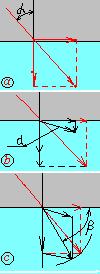
 = m
×
= m
×
 ×
×  ×
×  - this motion is in three dimensions. dimensions. If one or two coefficients are absent we have some particular
cases: motion on line, in plane. It's also clear that
energy has no forms. For example, Heat is also a motion(of electrons),
radiations are a motion of micro particles. It doesn't matter
what
is the size of a moving body: it's not important whether it's a
micro particle(electron, neutron) or a macro particle( stone, meteor).
Hence we can consider any motion is radiation.
- this motion is in three dimensions. dimensions. If one or two coefficients are absent we have some particular
cases: motion on line, in plane. It's also clear that
energy has no forms. For example, Heat is also a motion(of electrons),
radiations are a motion of micro particles. It doesn't matter
what
is the size of a moving body: it's not important whether it's a
micro particle(electron, neutron) or a macro particle( stone, meteor).
Hence we can consider any motion is radiation. it's a stiffen wave. Part of energy is spent for the heating
of
lead , another part transforms into sound , the other one (in the form
of a wave) for the bullet deformation , the rest of energy is
transformed into armor. While flying the bullet transforms a part of
energy into sound, a part is spent to interact with
air -
it transforms motion to the atoms of air.
it's a stiffen wave. Part of energy is spent for the heating
of
lead , another part transforms into sound , the other one (in the form
of a wave) for the bullet deformation , the rest of energy is
transformed into armor. While flying the bullet transforms a part of
energy into sound, a part is spent to interact with
air -
it transforms motion to the atoms of air. The
standard proof of refraction was made by Guigence, well, he did
his best. We'll use our vector algebra here. Do you still remember the "Nest dolls"? The beam of light falls on water surface at angle alfa.
At the moment the beam is over the very surface let's imagine the
energy vector as two vectors. One of them is directed downwards,
the other one is directed to the right (fig. a). And now
the beam reaches the water surface, hence the part of energy is spent,
let's say, "for illuminating" a certain volume of water. The vector
directed downwards consists of two vectors (see fig. b).
One of them is spent for "illumination", the other is spent for
farther movement of the beam. And the vector directed to the
right also consists of two vectors but (!) one of them which is
spent for "illumination" is directed downwards, therefore their
equalizer (in fig. b it's denoted as d ) will be somehow deflected downwards.
The
standard proof of refraction was made by Guigence, well, he did
his best. We'll use our vector algebra here. Do you still remember the "Nest dolls"? The beam of light falls on water surface at angle alfa.
At the moment the beam is over the very surface let's imagine the
energy vector as two vectors. One of them is directed downwards,
the other one is directed to the right (fig. a). And now
the beam reaches the water surface, hence the part of energy is spent,
let's say, "for illuminating" a certain volume of water. The vector
directed downwards consists of two vectors (see fig. b).
One of them is spent for "illumination", the other is spent for
farther movement of the beam. And the vector directed to the
right also consists of two vectors but (!) one of them which is
spent for "illumination" is directed downwards, therefore their
equalizer (in fig. b it's denoted as d ) will be somehow deflected downwards.  Send a message, please
Send a message, please 